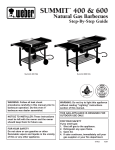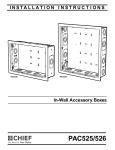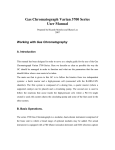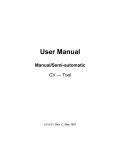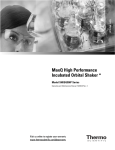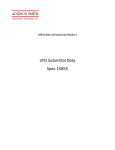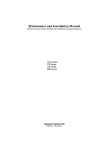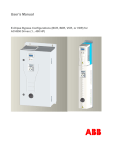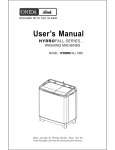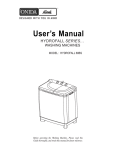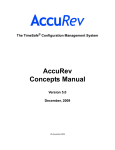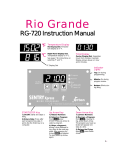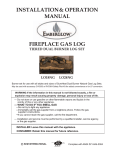Download PET User Manual
Transcript
User Manual Pyrogenic External Torch 900 — SERIES PET - 986 PET - 988 PET - 989 PET - 992 PET - 993 PIB - 987 EX.6.01, REV. J, January 2001 Thank you for purchasing Persys Pyrogenic External Torch. This manual has been written to provide all relevant instructions for installing, operating and maintaining your Pyrogenic External Torch. We recommend you read these instructions before attempting to install or operate your External Torch to ensure the maximum service life of your equipment. Persys Technology Ltd. believes the information contained in this publication is accurate as of its latest printing date, and reserves the right to make changes in specification and information without prior notice. Persys is not responsible for any inadvertent errors. The terms and conditions governing the sales of Persys products and the licensing and use of software consist solely of those set forth in the contracts between Persys and its customers. No representation or other affirmation of fact contained in this publication, including but not limited to statements regarding capacity, response time performance, suitability for use or performance of products described herein shall be deemed to be a warranty by Persys for any purpose or give rise to any liability by Persys whatsoever. In no event shall Persys be liable for any incidental, indirect, special or consequential damages whatsoever (including but not limited to loss of profits) arising out of or relating to this publication or the information contained in it, even if Persys has been advised , knew or should have known of the possibility of such damages. The products described in this document are confidential and propriety of Persys or its licensors. No part of this document may be reproduced in any form, including by electronic retrieval systems, without prior written permission of Persys. Copyright 1993 by Persys Technology Ltd., (Persys) All rights reserved TABLE OF CONTENTS 1.0 2.0 3.0 4.0 5.0 INTRODUCTION 1 1.1 Scope of this Manual 1 1.2 General Features 1 1.3 Description 1 1.3.1 Overview 1 1.3.2 The External Torch 2 1.3.3 The PIB-987 Torch Controller 5 TECHNICAL DATA 11 2.1 Materials 11 2.2 Dimensions 11 2.3 Weight 11 2.4 Ignition Specifications 12 2.5 Flows/Flame Specifications 12 2.6 Cooling Specifications 12 2.7 Power 12 2.8 Safety Features 13 2.9 Options 13 INSTALLATION 14 3.1 Safety 14 3.2 Unpacking 14 3.3 External Torch Component Assembly and Installation in Furnace 25 OPERATION 28 4.1 Start-Up Procedure 28 4.2 Operational Description 30 MAINTENANCE / TROUBLESHOOTING 31 5.1 Introduction 31 5.2 Preventive Maintenance 31 5.3 Troubleshooting 32 5.4 Component Replacement 33 5.5 External Torch Dismantling and Reassembly 33 5.6 Service 37 6.0 SPARE PARTS AND ACCESSORIES 38 6.1 38 Spares APPENDIX A Description of Inputs/Outputs APPENDIX B Installation of Injector Heat Shield Set on External Torch APPENDIX C Customer Pre-Installation Preparation 40 40 45 45 47 47 ILLUSTRATIONS FIGURE 1 — 1 EXTERNAL TORCH INTERCONNECTIONS 4 FIGURE 1 — 2 PIB-987 FRONT PANEL 5 FIGURE 1 — 3 PIB-987 BACK PANEL 7 FIGURE 1 — 4 PIB-987 ELECTRONIC SCHEMATIC 9 FIGURE 1 — 5 PIB-987 PCB PLACEMENT INCLUDING JUMPERS CONFIGURATION SET UP, COMPONENT SIDE 10 FIGURE 3 — 1 PET-986 16 FIGURE 3 — 2 PET-988 18 FIGURE 3 — 3 PET-989 20 FIGURE 3 — 4 PET-992 22 FIGURE 3 — 5 PET-993 24 FIGURE 3 — 6 CHAMBER ALIGNMENT − INJECTOR ORIENTATION 27 FIGURE 4 — 1 STEAM START RECIPE — RECOMMENDED FLOW CHART 29 TABLE A — 1 EXTERNAL TORCH ELECTRICAL PINOUT 40 TABLE A — 2 PIB-987 BACK PANEL CONNECTORS PINOUT 41 FIGURE B — 1 INJECTOR HEAT SHIELD SET (OPTIONAL) 46 FIGURE C — 1 CUSTOMER PRE-INSTALLATION PREPARATION 47 Principle Changes in Present Revision (J) 1. Back and front panel design was changed. 2. Fig. 14, PIB-987 Electronic Schematic was replaced. 3. Fig 15 was canceled; same information is displayed now in the new Fig 15. 4. Fig. 16, PIB-987, PCB placement was replaced (now Fig 15). 5. Section 3.3, External Torch Component Assembly and Replacement, a warning for model PET-989 was added. 6. Section 6.1, Spares, the controller was added to spare parts list. Principle Changes in Previous Revision (I) 1. Section 2.7, power specifications were changed. 2. Section 4.2, Operational Description, a warning was added. Principle Changes in Previous Revision (H) 1. Figures 14 and 16, Electronic schematic and PCB placement were updated. Principle Changes in Previous Revision (G) 2. Two new External Torches are added to manual. Principle Changes in Previous Revision (F) 1. The name of the Ignition Chamber Assembly is standardized throughout this manual. 2. Part numbers and names, (Section 6.0, Spare Parts & Accessories), pg. 38-39. 3. Drawing of new lamps connector Assy. on the PIB rear Plate, pg. 8. 1.0 INTRODUCTION 1.1 Scope of this Manual This manual provides the installation, adjustment, operation and maintenance procedures of the PET 900 series: PET-986 PET-988 PET-989 PET-992 PET-993 PIB-987 Torch Controller 1.2 General Features The PET-900 Series includes the following features: Simple to operate Easy to maintain Operational status LED display Alarm status LED display Safety interlocks Adapts to most furnace/gas system configurations Minimal impact on process duration 1.3 Description 1.3.1 Overview The External Torch safely ignites a controlled mixture of Hydrogen and Oxygen, and maintains a flame for generating high purity water vapor or steam. Since the External Torch is mounted outside the main process chamber, steam for wet (pyrogenic) oxidation processes can be delivered to the process chamber with minimal impact on the process chamber's temperature profile. The PET-900 series (including all PET MODELS - 986, 988, 989, 992, 993) consists of the External Torch, where H2 /O2 combustion occurs, and the PIB-987 Torch Controller which controls ignition temperature condition and H2 flow. Digital and analog outputs from the PIB-987 can be hardware and software interlocked with the furnace controller. Rev. J, January 2001 Pyrogenic External Torch — 900 SERIES 1 1.3.2 The External Torch The PET-900 series includes external torches incorporating unique features designed specially for the following applications: PET-986: Designed for 125 - 200 mm wafer size horizontal furnaces. PET-988: Designed for vertical furnaces and small horizontal furnaces. PET-989: Designed for vertical furnaces and small horizontal furnaces with Silicon Carbide process tubes. PET-992: Designed for vertical furnaces and small horizontal furnaces; compact design. PET-993: Designed for 125 -200 mm wafer size horizontal furnaces with Silicon Carbide process tubes. The External Torch includes the following: Ignition Chamber Assembly Injector (Quartz) Combustion Chamber (Quartz) Cooling System Perforated Cover Main Body Ignition Chamber Assembly The Ignition Chamber Assembly consists of a protective box made of a Stainless Steel exterior and a Ceramic interior. When assembled for use in the External Torch, the Ignition Chamber Assembly includes two 500W quartz Tungsten Halogen ignition lamps designed to heat the ignition chamber up to 760°C and ignite the Hydrogen and Oxygen. Injector The Injector is a small quartz tube seated between the two ignition lamps, designed to maintain the gas flow dynamics so the flame is distanced from both the injector tip and chamber walls. The injector unit includes Hydrogen and Oxygen gas inlets, 1/4" and 3/8" respectively, and a type K thermocouple placed in a quartz well inside the injector, at the point of ignition, measuring the ignition temperature. Combustion Chamber The Combustion Chamber is a quartz tube comprising of two quartz encapsulated Silicon Carbide "Hot Spots" aligned to the ignition point, contributing to a faster ignition and higher ignition temperature. A quartz bypass in the Combustion Chamber enables the flow of additional gasses besides the ignition gas lines. The Combustion Chamber holds the injector on one side and is connected to the tube with a female ball joint outlet on the other side. Rev. J, January 2001 Pyrogenic External Torch — 900 SERIES 2 NOTE: The PET-989 and PET-993 models have a shorter female ball joint, designed to endure thermal expansion of male ball joint on the Silicon Carbide furnace tube during process, thus preventing breakage of the Combustion Chamber quartz. Cooling System The Combustion Chamber is cooled by compressed air flowing into a Cooling System (Cooling Ring & Jacket), which is a double wall Stainless Steel heat exchanger. The air flows in through a Swagelok type inlet and out through an HPS type exhaust outlet. The Cooling Jacket has an opening at the bottom, enabling operation of the UV Detector. Perforated Cover The exterior of the External Torch is covered by a perforated, electropolished Stainless Steel box to protect against burns. A thermostat is positioned on the cover to sense skin temperature (maximum 90°C). The Main Body The External Torch is placed on a height adjustable Steel and black anodized Aluminum construction, the Stage. The stage includes the UV Detector unit, the electrical connection board where lamps are connected and the electronic connection board. The stage type is unique for each PET model: PET-986 Height is adjustable using a single adjustment knob. PET-988 Designed for a small space, height is adjustable using four pliable legs. PET-989 Designed for Silicon Carbide process tubes, consists of a double sliding base to overcome thermal expansion of Silicon Carbide process tubes during process. Moving length fluctuates by ± 10 mm. Height is also adjustable using four pliable legs. PET-992 Designed for a small space and low height of the process tube steam inlet, from shelf (as low as 70 mm). Height is adjustable using four pliable legs. PET-993 Designed for Silicon Carbide process tubes, consists of a double sliding base to overcome thermal expansion of Silicon Carbide process tubes during process. Height is adjustable using a single adjustment knob. Rev. J, January 2001 Pyrogenic External Torch — 900 SERIES 3 External Torch Interconnections The interconnect board on the External Torch (see Figure 1 — 1) interconnects all the related gauges from the External Torch, such as the UV detector, skin over temp sensor and TC type K output, into a D type connector. In addition, there is a LED that is lit when lamps are on or flame is on. All the outputs are connected by a cable from the D type connector at the External Torch to the back panel of the PIB-987. A second connector on the External Torch supplies the AC power to the lamps and is connected by a cable to the "TO LAMPS" connector on the PIB-987 back panel. Figure 1 — 1 External Torch Interconnections Rev. J, January 2001 Pyrogenic External Torch — 900 SERIES 4 Both connectors to the lamps on the External Torch and the PIB-987 are the same for 220V and 110V AC. The difference in voltage is controlled by the cable interconnect between the External Torch and the PIB-987. The External Torch Electrical pinout is presented in Table 1 APPENDIX A. 1.3.3 The PIB-987 Torch Controller The External Torch is interfaced to the DDC by the model PIB-987 Torch Controller. The PIB-987 includes an ON/OFF power switch with LIGHT ON indicator, Torch Status and Alarm LED’s on its front panel (see Figure 1 — 2). Figure 1 — 2 PIB-987 Front Panel Rev. J, January 2001 Pyrogenic External Torch — 900 SERIES 5 Torch Controller Indicators POWER Indicates power is available for system operation. START Indicates an H2 request has initiated the automatic sequence of H2 interlocks and safety features. LAMPS 1&2 Indicate both ignition lamps are lit. IGNITION Indicates the ignition lamp temperature, monitored by a thermocouple, is at least 760°C. H2 ENABLE Indicates all safety interlocks have been satisfied and H2 is permitted to flow. TORCH ON Indicates detection of H2 flame by the UV detector SKIN OVERTMP Indicates the skin temperature of the torch housing is 90°C or above. Test Mode The Test Mode push button is positioned inside a 3-mm hole, located below the SKIN OVERTMP indicator LED. Test Mode can be activated by pressing the button with any small tool inserted through the hole. The Test Mode provides the option to check the PIB-987 and the External Torch manually, up to the ignition point, without having to start the system from the DDC (Direct Digital Control) and without turning on any gasses. It is used for maintenance troubleshooting, where the indicator lamps are checked and the achievement of correct temperature for ignition condition is tested. Back Panel The PIB-987 back panel (shown in Figure 1 — 3) includes the following connectors: External Torch connector, connected to the D type connector on the interconnect board. Two I/O connectors, connected to the DDC furnace controller. "TO LAMPS" connector, which supplies the power to the lamps connector in the External Torch and AC line input connector. The pinout of the PIB-987 back panel connectors is presented in Table 2, APPENDIX A. Rev. J, January 2001 Pyrogenic External Torch — 900 SERIES 6 Figure 1 — 3 PIB-987 Back Panel Description of Operation Connection through the PIB-987 The furnace operator programs the process recipe with O2 and H2 MFC settings and solenoid requests for initiation of torch ignition. Once the PIB-987 Torch Controller is started by the DDC recipe, the PIB turns on the Halogen ignition lamps. The ignition chamber reaches the operating temperature of 760°C within 55 seconds and the actual temperature is verified by the under temperature thermocouple sensing circuit, following which a digital output signal is transferred to the DDC enabling the H2 flow. Ignition will then occur within 10 seconds. The H2 solenoid is interlocked by the PIB-987 and can be activated only if ignition temperature is reached or if the UV detector confirms the presence of a flame. After 2 − 3 minutes, the lamps are automatically shut off by the controller. The PIB-987 includes an automatic twominute delay before lamps can be turned on again. Rev. J, January 2001 Pyrogenic External Torch — 900 SERIES 7 Description of Ignition Condition The PIB-987 will enable the opening signal to the H2 valve, only when the External Torch reaches the ignition condition. Ignition condition is reached when ignition temperature of 760°C or higher is achieved. In any case of UV shutoff the PIB-987 will shut off the H2 valve. PIB-987 Electronic schematic is presented in Figure 1 — 4. PIB-987, PCB Placement is presented in Figure 1 — 5. Rev. J, January 2001 Pyrogenic External Torch — 900 SERIES 8 Figure 1 — 4 PIB-987 Electronic Schematic Rev. J, January 2001 Pyrogenic External Torch — 900 SERIES 9 Figure 1 — 5 PIB-987 PCB Placement including Jumpers Configuration Set Up, Component Side Rev. J, January 2001 Pyrogenic External Torch — 900 SERIES 10 2.0 TECHNICAL DATA 2.1 Materials Main Frame Electropolished Stainless Steel and Aluminum black anodized construction Combustion Chamber Quartz (GE-214 or equivalent), Norton Silicon Carbide grains encapsulated in quartz. Injector Precision machined Quartz (GE-214 or equivalent). Steam Outlet Standard 35/25 (or 28/15) female ball joint. NOTE: For PET-989 and PET-993 (compatible with SiC process tubes), the female ball joint of the steam outlet underlaps the Crystar male ball joint by -10° from center to avoid quartz cracking due to thermal expansion. 2.2 Dimensions Standard PET-986 Footprint: 450 × 150 mm Height: Low Profile PET-988 Foot print: 450 × 150 mm Height: SiC PET-989 210 mm minimum Footprint: 450 × 150 mm Height: Very Low Profile PET-992 SiC PET-993 218 mm minimum Footprint: 450 × 180 mm Height: 145 mm minimum Footprint: 450 × 150 mm Height: PIB-987 2.3 252 mm minimum 260 mm minimum 107 × 130 × 260 mm Weight External Torch, including quartzware 9kg (20lbs) PIB-987 1kg (2lbs) Rev. J, January 2001 Pyrogenic External Torch — 900 SERIES 11 2.4 2.5 Ignition Specifications Ignition Time From room temperature to above 800°C in 40-55 seconds, using two 500W Halogen lamps. No stand-by heating of the ignition chamber. Hydrogen Flow During Ignition 1 - 2 SLM Oxygen Flow During Ignition 1 - 2 SLM Hydrogen/Oxygen Ratio 1:1 Flows/Flame Specifications Flame Contour Maximum 20 mm in diameter Flame Length 130 mm at 1 SLM Hydrogen, ratio of 1.8 150 mm at 7 SLM Hydrogen, ratio of 1.8 130 mm at 10 SLM Hydrogen, ratio of 1.8 130 mm at 15 SLM Hydrogen, ratio of 1.8 Hydrogen/Oxygen Ratio Between 1.9:1 and 1:1 NOTE 1: The flame is positioned in the middle of the combustion chamber. The shape and diameter of the tip nozzle maintain the gas flow dynamics thus ensuring that flame is distanced from the quartz by 0.5 mm or more. This design prevents any quartz devitrification. NOTE 2: For Hydrogen flows up to 5 SLM the ratio can be 0.5 if required for an Oxygen diluted steam. 2.6 2.7 Cooling Specifications Air Flow 5 - 6 CFM (140 - 170 LM) Air Inlet Pressure 60 - 80 PSI Air Inlet Swagelok type (1/4") Air Cooling Outlet HPS type NW 10 ISO KF Power During Ignition Period AC 110/230 VAC 50/60Hz 1100VA (for maximum of 2 minutes). During Process Period 20VA max. for the PIB only Rev. J, January 2001 Pyrogenic External Torch — 900 SERIES 12 2.8 2.9 Safety Features Ignition Temperature Measured by a type K thermocouple mounted in a quartz well inside the injector located near point of ignition. UV Detector Spectral sensitivity 185 to 260 nm suitable for Hydrogen flame, indication LED on display at the External Torch for "Flame On". Induction Current Sensor Ensures Halogen lamps functionality Skin Temperature Measured by a thermistor, sets alarm on PIB- 987 if skin temperature exceeds 90°C. Alarm does not stop process. Exterior Cover The exterior cover of the External Torch system is a perforated, electropolished Stainless Steel box to protect against burns. Options Configuration Interchangeable left and right configuration by changing direction of perforated cover and ignition chamber assembly cover. Stages According to model number. System Configuration With or without bypass, various ball joint types. System Height System height can be adjusted to meet needs. Software Customized controller software available upon request. Rev. J, January 2001 Pyrogenic External Torch — 900 SERIES 13 3.0 INSTALLATION 3.1 Safety Installation of the External Torch must be performed by a competent technician. When installing your External Torch for the first time it is compulsory to call a Persys representative. Details of specific safety precautions are given throughout the instructions at the appropriate points. Wear appropriate safety gear when handling contaminated components. Check that all required components are available and of the correct type before starting work. Ensure that the installation technician is familiar with quartz safety handling procedures. 3.2 Unpacking NOTE: Quartz parts (Chamber and Injector) should be cleaned prior to installation according to customers' quartzware cleaning procedures. CAUTION Quartzware is packed separately in a protective carton. Do not handle quartzware with bare hands, use cleanroom gloves. Quartzware is fragile, handle it with care. When unpacking the box you will find the manual and documentation on top, and the following parts, packed in separate boxes: The main unit and the stage. The cooling system. All quartz parts: Combustion Chamber, and Injector. The PIB-987 Controller, including cables and connectors. Small parts and accessories. Rev. J, January 2001 Pyrogenic External Torch — 900 SERIES 14 Parts description of all models, for reference, is given in the following figures: • 3 — 1 PET-986 • 3 — 2 PET-988 • 3 — 3 PET-989 • 3 — 4 PET-992 • 3 — 5 PET-993 PET-986 Figure Description 1. Cooling Ring 14. Perforate Cover Assembly 2. Quartz Chamber 15. Clamping Plate 3. O' Ring 16. Skin Temperature Assembly 4. Cooling Jacket 17. Support Pad 5. Ignition Chamber Assembly 18. Ceramic Spacer 6. Thomas Pinch Clamp 19. Stand Off 7. Quartz Injector 20. Power Connector Assembly 8. Thermocouple Assembly 21. UV Detector Assembly 9. Hydrogen Teflon Fitting 22. Extension Pipe 10. Oxygen Teflon Fitting 23. Level Mechanism 11. Lamp Mounting Assembly 24. Main Adjustment Knob 12. Lamp Socket 25. Connection Board Assembly 13. Halogen Lamp Rev. J, January 2001 Pyrogenic External Torch — 900 SERIES 15 Figure 3 — 1 PET-986 Rev. J, January 2001 Pyrogenic External Torch — 900 SERIES 16 PET-988 Figure Description 1. Cooling Ring 14. Perforate Cover Assembly 2. Quartz Chamber 15. Clamping Plate 3. O' Ring 16. Skin Temperature Assembly 4. Cooling Jacket 17. Support Pad 5. Ignition Chamber Assembly 18. Ceramic Spacer 6. Thomas Pinch Clamp 19. Stand Off 7. Quartz Injector 20. UV Detector Assembly 8. Thermocouple Assembly 21. Power Connector Assembly 9. Hydrogen Teflon Fitting 22. Level Adjustment Screw 10. Oxygen Teflon Fitting 23. Level Adjustment Screw Nut 11. Lamp Mounting Assembly 24. Connection Board Assembly 12. Lamp Socket 13. Halogen Lamp Rev. J, January 2001 Pyrogenic External Torch — 900 SERIES 17 Figure 3 — 2 PET-988 Rev. J, January 2001 Pyrogenic External Torch — 900 SERIES 18 PET-989 Figure Description 1. Cooling Ring 14. Perforate Cover Assembly 2. Quartz Chamber 15. Clamping Plate 3. O' Ring 16. Skin Temperature Assembly 4. Cooling Jacket 17. Support Pad 5. Ignition Chamber Assembly 18. Ceramic Spacer 6. Thomas Pinch Clamp 19. Stand Off 7. Quartz Injector 20. UV Detector Assembly 8. Thermocouple Assembly 21. Power Connector Assembly 9. Hydrogen Teflon Fitting 22. Level Adjustment Screw 10. Oxygen Teflon Fitting 23. Level Adjustment Screw Nut 11. Lamp Mounting Assembly 24. Precision Linear Slide 12. Lamp Socket 25. Connection Board Assembly 13. Halogen Lamp Rev. J, January 2001 Pyrogenic External Torch — 900 SERIES 19 Figure 3 — 3 PET-989 Rev. J, January 2001 Pyrogenic External Torch — 900 SERIES 20 PET-992 Figure Description 1. Cooling Ring 13. Halogen Lamp 2. Quartz Chamber 14. Perforate Cover Assembly 3. O' Ring 15. Clamping Plate 4. Cooling Jacket 16. Skin Temperature Assembly 5. Ignition Chamber Assembly 17. Support Pad 6. Thomas Pinch Clamp 18. Ceramic Spacer 7. Quartz Chamber 19. Stand Off 8. Thermocouple Assembly 20. Power Connector Assembly 9. Hydrogen Teflon Fitting 21. UV Detector Assembly 10. Oxygen Teflon Fitting 22. Connection Board Assembly 11. Lamp Mounting Assembly 23. Quartz Adapter 12. Lamp Socket 23. Level Adjustment Screw Rev. J, January 2001 Pyrogenic External Torch — 900 SERIES 21 Figure 3 — 4 PET-992 Rev. J, January 2001 Pyrogenic External Torch — 900 SERIES 22 PET-993 Figure Description 1. Cooling Ring 15. Clamping Plate 2. Quartz Chamber 16. Skin Temperature Assembly 3. O' Ring 17. Support Pad 4. Cooling Jacket 18. Ceramic Spacer 5. Ignition Chamber Assembly 19. Stand Off 6. Thomas Pinch Clamp 20. Power Connector Assembly 7. Quartz Chamber 21. UV Detector Assembly 8. Thermocouple Assembly 22. Extension Pipe 9. Hydrogen Teflon Fitting 23. Level Mechanism 10. Oxygen Teflon Fitting 24. Main Adjustment Knob 11. Lamp Mounting Assembly 25. Connection Board Assembly 12. Lamp Socket 26. Stopper Pin 13. Halogen Lamp 27. Precision Linear Slide 14. Perforate Cover Assembly Rev. J, January 2001 Pyrogenic External Torch — 900 SERIES 23 Figure 3 — 5 PET-993 Rev. J, January 2001 Pyrogenic External Torch — 900 SERIES 24 After carefully unpacking the boxes, check the components against the packing list to ensure the shipment is complete. All External Torch components should be visually inspected for any damage that may have occurred during transit. If evidence of damage is found or any components are missing, notify Persys and the carrier immediately. 3.3 External Torch Component Assembly and Installation in Furnace WARNING FOR MODEL PET-989 To prevent damage to linear slide bearings, do not remove adjustable screw legs from base plate. For best results, assemble the components in the following order: 1. Swing open the perforated cover on the External Torch assembly. 2. Swing open the Ignition Chamber Assembly cover. 3. Locate a clean smooth counter or table top to use as a work space and unpack the following components: Quartz Combustion Chamber Quartz Injector Thomas Pinch Clamp O' Ring 4. Gently insert the Combustion Chamber into the Cooling Jacket. 5. Carefully slide the Cooling Ring with a swing turn motion over the end of the Combustion Chamber onto the Cooling Jacket, and tighten the plumbing connection (union Swagelok fitting). 6. Place the # 120 O' Ring on the B/J of the Combustion Chamber. 7. Connect the Quartz Injector to the Combustion Chamber with the Thomas clamp. 8. Tighten Thomas Clamp - finger tight. 9. Carefully carry the Cooling Chamber/Quartz Assembly to the furnace and gently place it inside the External Torch assembly. The exhaust connection should be perpendicular to the shelf. Notice that the outer ring of the Combustion Chamber is placed in the outer part of the Ignition Chamber Assembly and the groove is seated on the Stainless Steel pin located on the Ignition Chamber Assembly (see Figure 3 —6). Rev. J, January 2001 Pyrogenic External Torch — 900 SERIES 25 10. Align the Cooling Chamber/ Quartz Assembly horizontally and in a straight line with the Ignition Chamber Assembly bore, by adjusting the support pads. Make sure the support pads are parallel to the Cooler. 11. Close the Ignition Chamber Assembly cover and close perforated Torch Assembly cover. 12. Connect the air-cooling supply line to the air inlet connection (elbow Swagelok fitting) on the Cooling Chamber assembly. 13. Connect the air exhaust line to the Cooling Jacket exhaust connection. 14. Loosen the ultratorr fitting at the end of the External Torch overtemp thermocouple. CAUTION Use extreme caution to avoid breaking the TC or gas inlets on the quartz injector. 15. Insert the Thermocouple through the end of the injector, and slide it all the way until the ultratorr fitting fits snugly over the end of the injector. 16. Tighten the ultratorr fitting to secure the thermocouple in place. 17. Attach the Teflon gaslines to the Teflon connectors. The Oxygen inlet port is larger than the Hydrogen inlet, and each Teflon fitting on the gaslines can only fit on its respective inlet port. 18. Adjust height of main body unit, if necessary, to align the torch Combustion Chamber to the process tube. Raise or lower the torch assembly until perfect alignment is obtained with process tube. 19. Install and tighten the ball joint clamp between the combustion chamber and the process tube. Rev. J, January 2001 Pyrogenic External Torch — 900 SERIES 26 Figure 3 — 6 Chamber Alignment − Injector Orientation Rev. J, January 2001 Pyrogenic External Torch — 900 SERIES 27 4.0 OPERATION WARNING Do not operate the External Torch before verifying that the Ignition Chamber Assembly is closed. Do not bypass External Torch interlocks or alarms. You are dealing with potentially explosive gasses. The External Torch must be operated by trained personnel. If the External Torch is not operated properly, the gas mixture may explode, shattering the quartzware or damaging the wafer process. 4.1 Start-Up Procedure Using inputs and outputs from the PIB-987, the steam start procedure recipe steps described in Figure 4 — 1 are recommended with your DDC. ATTENTION During ignition period: H2 and O2 setpoints should never exceed 2 SLM each. H2/O2 ratio must be 1. Rev. J, January 2001 Pyrogenic External Torch — 900 SERIES 28 Figure 4 — 1 Steam Start Recipe — Recommended Flow Chart Rev. J, January 2001 Pyrogenic External Torch — 900 SERIES 29 4.2 Operational Description Whenever H2 and O2 MFC setpoints are programmed and the respective solenoids are requested to energize, the PIB-987 Torch Controller begins the following sequence: 1. Start, Input from DDC turns on START LED. 2. Turn on ignition lamps; LAMP1 LED and LAMP2 LED are lit. 3. Turn on air coolant solenoid when temperature reaches 70°C. 4. H2 solenoid is inhibited until reaching ignition condition. 5. Ignition chamber reaches 760°C within 45 seconds and the undertemp thermocouple verifies temperature > 760°C. 6. IGNITION LED is lit and the ignition temp output is activated. 7. The H2 solenoid is activated; H2 ENABLE LED is lit. 8. Ignition will occur within 10 seconds through the DDC recipe. 9. Torch On, the UV Detector confirms the presence of a flame. 10. The TORCH ON LED is lit only when lamps are turned off by the DDC recipe. 11. The O2 and H2 MFCs are ramped to process setpoints by the DDC. WARNING Semi S-2 standards require the installer of the PET-900 series with the PIB-987 controller, to use the alarm signal (in case of a flameout during a pyrogenic process) as a latched signal in the host controller. It is recommended to flow H2 and O2 together while constantly maintaining the required process ratio. Note: Increasing O2 above the stychiometric ratio makes the flame smaller meaning that UV detection is more difficult. Rev. J, January 2001 Pyrogenic External Torch — 900 SERIES 30 5.0 MAINTENANCE / TROUBLESHOOTING WARNING Disconnect the electrical power from the equipment before attempting to service any electric components. During maintenance, wear eye and face protection. WARNING Temperature near the air-cooling outlet can rise to 200°C or higher. Please take extreme care when performing maintenance work in the source cabinet. 5.1 Introduction This section describes preventive maintenance, troubleshooting and component replacement for the 900 Series External Torch. 5.2 Preventive Maintenance External Torch preventive maintenance consists of periodic system adjustments, general cleaning, and visual safety checks. Routine Checks 1. Perform a flame failure check periodically by blocking the UV detector site path. Verify the FLAME OUT LED illuminates and the H2 ON LED turns off. 2. Check thermocouple positioning. 3. Check quartzware connections for any stressed or loose fittings, cracks or contamination. Rev. J, January 2001 Pyrogenic External Torch — 900 SERIES 31 Annual Preventive Maintenance Annual preventive maintenance is highly recommended to maintain superior performance. During annual PM the following components should be cleaned or replaced: 1. Quartz Combustion Chamber 2. Quartz Injector Tip NOTE: Since the injector is cleaned by 10:1 HF, the holes in the injector nozzle are etched so their diameter is increased. Due to this fact, it is recommended not to exceed a total of 500 minutes of quartz injector etch time in HF solution. For quartz dismantling instructions, see Section 5.5. 5.3 Troubleshooting NOTE: The PIB-987 Torch Controller includes a two-minute delay feature before lamps can be turned on again. If lamps don’t light, wait two minutes and try again. The following tests should be performed whenever a problem arises or whenever the PET system has been idle for an extended period. 1. Create a short torch test recipe at the DDC similar to your standard process recipe with a short steam cycle. 2. Start the torch test recipe. 3. Verify that LED's are lit in the correct sequence. 4. Verify the existence of a flame by placing a mirror over the site port. Test Mode The Test Mode option is a manual test mode used only for maintenance troubleshooting, and it enables the user to check the PIB-987 and the External Torch up to ignition conditions, without having to start the system from the DDC and without having to turn on any of the gasses. In order to initiate the test mode, insert a small tool through the test mode hole, located on the PIB-987 Torch Controller, and press the push button behind this hole. The test mode will check the following: Turn on of lamps. Accomplishment of correct temperature for ignition. Rev. J, January 2001 Pyrogenic External Torch — 900 SERIES 32 5.4 Component Replacement The following components should be checked and replaced as recommended below: UV Detector Assembly The UV detector should be replaced every year. Tungsten Halogen Lamps Lamps should be replaced every year. Ignition Chamber Assembly Should be replaced only if the white ceramic is damaged. For dismantling of any of these parts, see Section 5.5. 5.5 External Torch Dismantling and Reassembly WARNING Before you attempt to dismantle the External Torch, it is required to comply with the precautions given below. If you do not, you can cause injury to people and damage to equipment: Disconnect the External Torch from electrical and gas supplies. Disconnect External Torch from furnace tube. Beware of any sharp objects. When handling quartz, wear plastic gloves. Whenever any parts of the External Torch have to be cleaned or replaced (according to our recommendation), or whenever troubleshooting requires so, dismantle External Torch according to the following procedures: Rev. J, January 2001 Pyrogenic External Torch — 900 SERIES 33 Lamp Replacement WARNING Store spare lamps in original packaging. Do not handle the lamps with bare hands. 1. For all types of PETs, except PET-992: 1.1. Disconnect air inlet and exhaust plumbing connections from Cooling Chamber. 1.2. Open Perforated Cover. 1.3. Remove TC from Injector. 1.4. Release gaspipe holder. 1.5. Dismantle gasline Teflon fittings. 1.6. Disconnect Thomas Clamp and remove Injector. 1.7. Open Ignition Chamber Assembly cover. 1.8. Remove Cooling System together with Quartz Chamber. 1.9. Remove the two screws holding the Ignition Chamber Assembly and pull out Ignition Chamber Assembly. Take care not to pull Lamp Base Assembly so electrical wires will not tear. 1.10. Open Lamp Base screw stopper and remove lamp base. 1.11. Replace lamp. 1.12. Return Ignition Chamber Assembly to place. 1.13. Reconnect electrical wires to connector. 1.14. Adjust Ignition Chamber Assembly in place and close screws finger tight. 1.15. Return Cooling System together with Quartz Chamber. 1.16. Reconnect Injector to Quartz Chamber with Thomas Pinch Clamp. 1.17. Close Ignition Chamber Assembly. 1.18. Assemble gasline Teflon fittings. 1.19. Fasten gaspipe holder. 1.20. Return TC to Injector. 1.21. Close Perforated Cover. 1.22. Connect air inlet and exhaust plumbing connections to Cooling Chamber. Rev. J, January 2001 Pyrogenic External Torch — 900 SERIES 34 2. PET-992 Lamp Replacement 2.1. Open Lamp Base screw stopper and remove lamps assembly. 2.2. Replace lamp. 2.3. Insert lamps assembly, and close lamp base stopper screw. Cooling System and Quartz Components Dismantling WARNING When handling quartz parts always wear plastic gloves. Do not attempt to touch quartz — it might be hot!! 1. Disconnect air inlet and exhaust plumbing connections from Cooling Chamber. 2. Open Perforated Cover. 3. Remove TC from Injector. 4. Release gaspipe holder. 5. Dismantle gasline Teflon fittings. 6. Disconnect Thomas clamp and remove Injector. 7. Open Ignition Chamber Assembly cover. * For PET-992 only, unscrew lamps assembly screw halfway. 8. Remove the Quartz Chamber together with Cooling System. 9. Remove the O' Ring from Quartz Chamber. 10. Gently pull back the Cooling Ring until it is released from the Cooling Jacket. NOTE: The Cooling Jacket must be pulled very carefully so you will not damage the quartz or break it. 11. With a swing turn motion, remove Cooling Ring through the Combustion Chamber ball joint and the quartz bypass. 12. Gently pull out the Quartz Chamber. Rev. J, January 2001 Pyrogenic External Torch — 900 SERIES 35 Reassembly Reassemble in the reverse sequence to dismantling: 1. Insert Chamber into Cooling Jacket. 2. With a swing turn motion insert the Cooling Ring through the Combustion Chamber. 3. Close the Union fitting screw finger tight. 4. Place O' Ring on Quartz Chamber B/J. 5. Connect the Injector with the Thomas clamp. This can also be performed at a later step. 6. Check that the Ignition Chamber Assembly is open and with a swing turn motion put the whole system inside. Notice that the outer ring of the Combustion Chamber is placed in the outer part of the Ignition Chamber Assembly and the groove is seated on the Stainless Steel pin located on the Ignition Chamber Assembly. This is very important so SiC "Hot Spots" are aligned to Halogen lamps. 7. Connect Injector with Thomas clamp (if you have not done so previously). Make sure Thomas clamp is positioned vertically upwards ± 30°. Close it finger tight. * For PET-992 only, screw lamps assy. back. 8. Close Ignition Chamber Assembly. 9. Connect gaslines. 10. Connect thermocouple. 11. Tighten gaslines to base plate by tightening gasline holder, in order to prevent accidental quartz breakage due to pulling of the gaslines. 12. Reconnect air inlet. 13. Close perforated cover. 14. Reconnect air exhaust. 15. Test system before operation. UV Detector 1. For all types of PETs, except PET-992 1.1. Disconnect the UV Detector connector from the electronic board. 1.2. For PET-986 and PET-993 only: Rev. J, January 2001 • Open the two screws holding the middle base plate from the shafts. • Lift out the middle base plate and put aside Pyrogenic External Torch — 900 SERIES 36 For PET-988/989: • 2. 5.6 Open perforated cover, Ignition Chamber Assembly cover and remove Cooling Assembly only. 1.3. Disconnect the two upper screws and take out the whole UV Detector unit. 1.4. Reassemble in the reverse sequence to dismantling. For PET-992 2.1. Disconnect the UV detector cooling tube at the T-Swagelok fitting. 2.2. Disconnect the UV detector from the electronic board. 2.3. Open the 2 Philips screws on the rear side and remove the holder with UV detector unit (remove the unit using a swing turn motion). 2.4. Disconnect the two front screws on the UV detector unit. 2.5. Disconnect the cooling inlet port (fitting and tube). 2.6. Reassemble in the reverse sequence to dismantling. Service Whenever a maintenance, troubleshooting or other problem arises, please call your local representative or Persys Technology, and we will be happy to assist. Rev. J, January 2001 Pyrogenic External Torch — 900 SERIES 37 6.0 SPARE PARTS AND ACCESSORIES 6.1 Spares Order spare parts and accessories from Persys Technology. When ordering, please state for each part required: PET Model Number Part Number Description of the Part The standard spare parts listed below are available for the PET Series. For non-standard spare parts, please contact your local rep. LINE NUMBER PART NAME PART NUMBER 1 Quartz Combustion Chamber EX.4.2XX According to customer requirements 2 Quartz Injector Tip EX.4.221 3 Thermocouple Assembly EX.5.400 Dual Thermocouple EX.5.401 4 Ceramic Spacer EX.3.003 5 Perforate Cover Assembly EX.3.300 6 Ignition Chamber Assembly EX.3.200 7 Cooling Assembly EX.4.300 8 Skin Temp Assembly EX.5.300 9 Teflon Fitting 1/4" -1/4" ST.6.610 10 Teflon Fitting 3/8" - 1/4" ST.6.620 11 11.1 UV Detector Assembly EX.5.200 11.2 UV Detector Assembly (for PET-992) EX.5.201 12 UV Detector Extension Pipe (For high torches) EX.5.223 13 UV Detector Cooling Assembly EX.5.240 14 Power Connector EL.4.180 15 O' Ring Viton 2-010 (For Thermocouple) ST.6.051 16 O' Ring # 120 16.1 Viton ST.6.060 16.2 Kalrez ST.9.060 Rev. J, January 2001 Pyrogenic External Torch — 900 SERIES 38 LINE NUMBER PART NAME 17 Precision Linear Slide BSP 10 35 SL (For PET-989 and PET-993) 18 PART NUMBER ST.5.001 Connection Board 18.1 PET-986 and PET-993 EX.5.100 18.2 PET-988/989 EX.5.101 18.3 PET-992 EX.5.102 19 Halogen Lamp 110V, 500W EX.3.256 20 Lamp Socket EX.3.255 21 Thomas Pinch Clamp # 35 ST.4.706 22 Stand Off 22.1 Stand Off 33 EX.2.002 22.2 Stand Off 44 EX.2.003 23 Heat Shield Set EX.3.280 24 Controller PIB-987 We recommend you keep the following Spare parts: Several Halogen Lamps One Quartz Chamber One Thermocouple One Quartz Injector Several Ceramic Spacers Several O' Rings # 120 Teflon Fittings One Controller, PIB-987 One UV Detector Rev. J, January 2001 Pyrogenic External Torch — 900 SERIES 39 APPENDIX A Description of Inputs/Outputs Table A — 1 External Torch Electrical Pinout NAME UV SKIN TEMP TC D TYPE LAMPS Rev. J, January 2001 PIN # DESCRIPTION 1 UV OUT 2 GND 3 + 12V 2 CONTACT 1 3 CONTACT 2 1 (+) 3 (-) 1 SKIN TEMP 1 (OUT) 2 TC (+) 3 TC (-) 6 SKIN TEMP 2 (OUT) 7 UV OUT 8 + 12 VOLT (POWER IN) 9 UV GND 1 LAMP 1 2 LAMP 1 RET. 3 CHASSIS 4 LAMP 2 5 LAMP 2 RET. Pyrogenic External Torch — 900 SERIES 40 Table A — 2 PIB-987 Back Panel Connectors Pinout LAMPS CONNECTOR (PLUG IN SCREW 5 PIN) (FEMALE) 1 LAMP 1 110/220 VOLT AC 2 LAMP 1 RET. 3 EARTH (CHASSIS) 4 LAMP 2 110 VOLT AC 5 LAMP 2 RET. PET-986 CONNECTOR (D TYPE 9 PIN) 1 SKIN TEMP (IN) CONTACT 1 2 TC (IN) + 3 TC (IN) 4 5 6 SKIN TEMP (IN) 7 UV (IN) 8 UV + 12 VOLT 9 UV GND Rev. J, January 2001 CONTACT 2 (POWER OUT) Pyrogenic External Torch — 900 SERIES 41 I/O CONNECTORS (BLOCKS TERMINAL 2×10 PIN) (FEMALE) 1 TORCH (UV) ON RELAY CONTACT N.O./N.C. 2 TORCH (UV) ON RELAY CONTACT 3 TO H2 VALVE RELAY CONTACT N.O. 4 TO H2 VALVE GND 5 SKIN TEMP. RELAY CONTACT N.O./N.C. 6 SKIN TEMP. RELAY CONTACT 7 IGNITION COND. RELAY CONTACT N.O./N.C. 8 IGNITION COND. RELAY CONTACT 9 LAMPS OK RELAY CONTACT N.O./N.C. 10 LAMPS OK RELAY CONTACT 11 START (IN) 5-32 VOLT 1000 Ohms (SSR) 12 START (IN) GND 13 H2 VALVE (IN) UP TO 100 VOLT 0.5 Amp. 14 H2 VALVE (IN) GND 15 AIR ON RELAY CONTACT 16 --- 17 GND 18 AIR ON RELAY CONTACT 19 TEMP REF 650°C PYRO LOW (-) 20 TEMP REF 650°C PYRO LOW (+) (HEADER) Rev. J, January 2001 Pyrogenic External Torch — 900 SERIES 42 Description of Inputs/Outputs The PIB-987 Torch Controller is a universal unit with functional inputs and outputs which can be connected and hardware/software interlocked through the furnace DDC and recipe. Pins 1 and 2, Torch (UV) On The output is a relay contact which is shorted during UV on, H2 flame exists and lamps are at "off" stage. Pins 3 and 4, To H2 Valve Relay contact is shortened only if the ignition condition is ready. This output should hardware interlock to the gas interface board H2 valve operation. This output is a basic safety interlock which enables turning on the H2 valve only if the following conditions exist: • Start signal from the DDC • Lamps are on • Ignition temperature is over 760°C, or • UV is on • Lamps are off Pins 5 and 6, Skin temp Relay contacts are shorted only if external torch housing is over 90°C. This option is implemented through the recipe as an alert but will not interrupt processing. Pins 7 and 8, Ignition Condition Relay output shorted only if ignition condition is ready to enable continuing the recipe up to the stage of Torch On. Pins 9 and 10, Lamps ok Relay contacts are shorted only if the internal electric current monitor detects current through the lamps. Pins 11 and 12, Start (IN) Any logical input (from 5 to 32 volts) from the DDC will operate the solid state relay for heating up the lamps and bring the External Torch to ignition condition. Pins 13 and 14, H2 Valve (IN) The two leads to the gas interface board for the H2 Valve on demand, are input to the PIB-987 and returned to the H2 Valve through pins 3 and 4 as described above. Rev. J, January 2001 Pyrogenic External Torch — 900 SERIES 43 Pins 15 and 18, Air Cooling on Relay output is shorted only if the Thermocouple Assembly in the ignition chamber exceeds 70°C, at which time the solenoid opens and air flows into the cooling jacket. Pins 19 and 20, Temp Ref 650°C This output is a voltage source equivalent for 650°C. The user should specify the need for this output and the type of TC the user uses for "pyro low" on the existing system. "Pyro low" interlock is used to prevent H2 gas flow to the furnace when furnace temperature is lower than 650°C. This interlock is only relevant for INTERNAL TORCH OPERATION where Hydrogen is ignited internally in the furnace. The equivalent (650°C) voltage supplied by the PIB-987 overcomes this interlock. Rev. J, January 2001 Pyrogenic External Torch — 900 SERIES 44 APPENDIX B Installation of Injector Heat Shield Set on External Torch NOTE: The information in this appendix is relevant only to those customers who specially order the Injector Heat Shield Set due to their requirements. Installation of the Injector Heat Shield Set on the External Torch is optional, and only necessary in cases in which there is water condensation in the Injector. For assistance in installation procedure, see Figures 3 — 1, B — 1. 1. Detach the Teflon fittings connecting the Hydrogen and Oxygen inlets to the injector (9, 10 - see Figure 3 — 1, p. 18-19). 2. Detach the Thomas Clamp (6) and reattach it so that the handle will be positioned downward toward the right as in the following picture: 3. Detach the clamping plate (15) from the top plate. 4. Loosen total of 4 screws on the ignition chamber assembly (5) - two screws on either side (A, B, C, D marked on Figure B — 1, p. 46). Take care not to misplace the spring washers. 5. Open the ignition chamber assembly (5). 6. Insert lower Aluminum shield with semi-circle pointing upward. Insert with care by slightly lifting the quartz, so that the shield slides easily into place. 7. Using the same screws of the ignition chamber assembly, screw the shield into place using two lower screws (A, B). 8. The Oxygen and Hydrogen inlets (9 and 10) must be reinstalled, ensuring that one of the straight sides of the bolt on the Teflon fittings be adjacent to the shield to ensure room for closing the top part of the ignition chamber assembly. NOTE: The Oxygen inlet (10) must always be on the opposite side of the axis of the perforated cover (14). 9. Connect the upper aluminum shield to the upper part of the ignition chamber assembly using screws C and D, ensuring the semicircle is pointing downward. 10. Check that all parts move smoothly without contact of quartz with the Aluminum. Rev. J, January 2001 Pyrogenic External Torch — 900 SERIES 45 Figure B — 1 Injector Heat Shield Set (optional) Rev. J, January 2001 Pyrogenic External Torch — 900 SERIES 46 APPENDIX C Customer Pre-Installation Preparation Figure C — 1 Customer Pre-Installation Preparation Rev. J, January 2001 Pyrogenic External Torch — 900 SERIES 47




















































